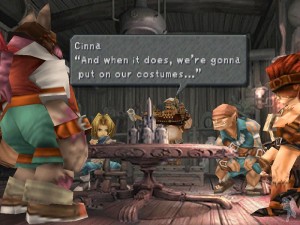Hello there once again, readerinos! It is indeed that time once again, time for another installment of the Final Fantasy retrospective! For those who have just joined our adventure, hop on over to part one or part two before giving this article a read-through. With exploration of the NES and SNES days of Final Fantasy complete, it is now time to look at Final Fantasy‘s third major era: the Sony PlayStation days. The transition to the PlayStation would give the series its first foray into 3D, and would complete the franchise’s transformation into a household name.
The first PlayStation entry, Final Fantasy VII, was released in 1997. Amusingly, Final Fantasy VII also received a poorly programmed PC port, and an eventual PSN release of the original. Notably, it was released in North America under the name Final Fantasy VII despite only being the fourth title released to the west. This distinction would confuse American gamers for years, but the mass popularity of the internet combined with subsequent re-releases of classic Final Fantasy titles would eventually clear up this confusion. Final Fantasy VII was the first in the series to feature 3D character models and graphics; the transition was admittedly a bit rough. Despite its blocky and pixelated world, Final Fantasy VII was revolutionary, and it soon exploded into mass popularity. Final Fantasy VII remains to this day the franchise’s most popular entry, and it saw several prequels and sequels as part of the Compilation of Final Fantasy VII.
It is difficult to say exactly what it is that made Final Fantasy VII so popular. The gameplay, while extraordinarily easy, is also rather innovative; rather than having magic or abilities, characters equip “Materia” to their weapons and armor in order to carry out commands like “Steal” or “Summon”. Final Fantasy VII‘s customizability gave players an unprecedented level of control over the party. Players wishing to have a thieving mage or a healing tank could do so with relative ease. Final Fantasy VII‘s story, while at times convoluted, was also much beloved by RPG fans. Final Fantasy VII notably did away with medieval or steampunk fantasy, favoring instead a more futuristic science-fiction setting. Final Fantasy VII certainly had a massive impact on gaming, and was the game that brought many of the modern generation of JRPG fans into the genre for the first time.
On the heels of Final Fantasy VII‘s success came the rather controversial and much maligned middle child of Final Fantasy VIII. Like its predecessor, Final Fantasy VIII also received PC and PSN ports. Final Fantasy VIII was a game that sought to be different from its predecessors while also attempting to build on what had made VII a hit. A modern, pseudo sci-fi setting and story were Final Fantasy VIII‘s major features. Additionally, use of a “Junction” system for magic and abilities, Final Fantasy VIII‘s rather tedious attempt to replicate the “Materia” system from VII made battles unique but also boring. There is little to say about Final Fantasy VIII that will decently explain the game’s mechanics, characters, or story; readers are instead highly encouraged to check out and join the Lusipurr.com Final Fantasy VIII feature and explore the game for themselves.
After the radically different seventh and eighth entries, the franchise decided to return to its roots with the final PlayStation title. Final Fantasy IX saw release only on the PlayStation and on PSN. While VII tried to be darker and more realistic, IX was instead a return to the cartoony fantasy style of earlier series entries. Final Fantasy IX is a fanboy’s dream; references to the other Final Fantasy games are scattered throughout the adventure. Final Fantasy IX used a relatively traditional battle system. While abilities could be learned through different equipment, each character had a clear and distinct role within the party, and there was no customization of party classes or jobs. Still, Final Fantasy IX was a popular game, as many gamers who felt unhappy about the series’ modernization could return fondly to the franchise. The vast differences between Final Fantasy VIII and Final Fantasy IX would cause the two entries to be one of the fanbase’s biggest points of contention. For years out, angry Final Fantasy fans have defended one game over the other, with countless internet flame wars erupting over which game is the better experience.
Regardless of one’s opinions of the PlayStation Final Fantasy entries, it is difficult to argue their influence. Final Fantasy VII truly popularized the series, and the next two entries would only further cement that popularity. The PlayStation era brought many gamers into the series and indeed even into RPGs for the first time; many gamers of the 90s will say that Final Fantasy VII was their first foray into the genre. The Final Fantasy series’ third era is to many its greatest; the franchise’s massive popularity is mostly the result of its PlayStation entries. The popularity of the PlayStation games is something that SquareSoft and Square Enix never could truly replicate, though the PlayStation 2 era certainly tried. Final Fantasy arguably defined the PlayStation JRPG, and any PlayStation owner is highly encouraged to pick up all three of the PlayStation Final Fantasy entries.


